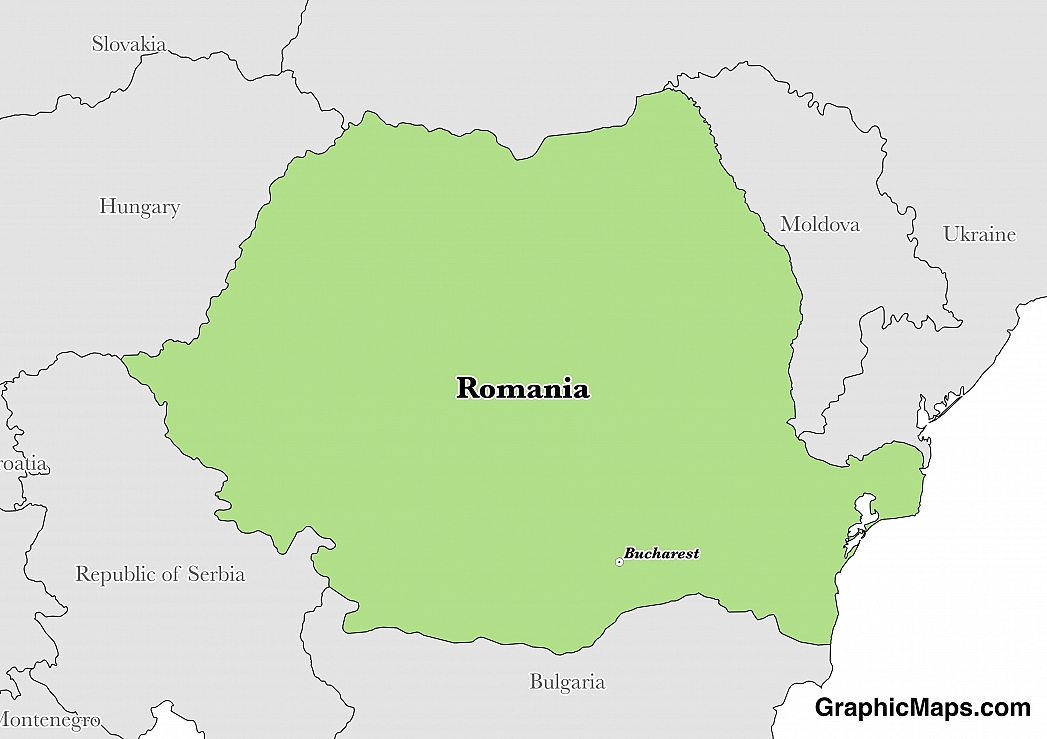Where is Romania?
Located in Southeastern Europe, Romania has a 2,844.00 km border with Bulgaria (605 km), Hungary (424 km), Moldova (683 km), Serbia (531 km) and Ukraine (601 km). It has a 225.00 km coastline. Disputes with Ukraine have existed in the past, concerning the Ukrainian-administered Zmiyinyy/Serpilor Island and Black Sea maritime boundary delimitation.
Bucharest was officially named Romania’s capital city in 1862. Bucharest is located near the Bulgarian border in the southeastern portion of the country, and has a population of over two million residents. Bucharest has a humid continental climate. Bucharest has been given the nickname of "Paris of the East" because of its cultural significance and elegant cityscape.
Read more on Romania's CapitalRomania is a European country covering 238,391.00 km2 of which 3.57% is water and 229,891.00 km2 is land. This makes it the 81st largest country in the world and twice the size of Pennsylvania; slightly smaller than Oregon. Its geographic coordinates are 46 00 N, 25 00 E and Bucharest is the capital city.
The name Romania comes from the Latin "Romanus", meaning "citizens of Rome".
Its ISO code is RO.
Geography
Romania has a mean elevation of 414 m above sea level.
It has an incredibly varied climate from subarctic in Siberia, tundra in the north, humid continental in European Russia, and mild along the coast. Its terrain is mountainous, with some rolling hills.
Population
Romania has a population of 21,599,736 making it the 57th largest in the world. The country's population is relatively evenly distributed.
Romanian is the official language. The majority ethnic group is Romanian, followed by Hungarian. The majority of the country is Eastern Orthodox.
A large majority of the inhabitants of Romania speak Romanian, which is the nation’s only official language as established by the 1991 Constitution of Romania. Originating from similar Romance languages as well as Latin and Cyrillic the Romanian alphabet includes 31 letters with three being added as late as 1982. All government, legal, and public education documents are mandated to be printed in Romanian. Common phrases in Romania include “Salut” for a casual greeting and “Mersi” meaning thank you. Besides the Romanian a small minority of the nation’s residents speak a variety of other languages such as English, French, German, Italian, Turkish, Ukrainian, and Russian.
Read more on Romania's LanguagesThe dialing code for the country is 40.
Government
Romania is an independent country. It gained independence from the Ottoman Empire in 1877. Its constitution was last ratified in 1991.
After a long and repressive political history, modern day Romania now operates under a democratically elected semi-presidential republic system. The country’s head of state, its president, may serve for a maximum period of two terms of five years each. The government is separated into three distinct branches: legislative, judicial, and executive. Parliament conducts the nation’s business in a gigantic structure known as the Palace of the Parliament which not only serves as the seat of government but has also become one of Romania’s most popular tourist destinations.
Read more on Romania's GovernmentEconomy
Factoring in Purchasing Power Parity, Romania's GDP is $441,000,000,000.00 (USD) with $22,300.00 (USD) per capita. This makes it the 43rd largest economy and its citizens the 78th richest in the world. The currency of Romania is the Leu (RON).
Its major export partners are Germany, Italy, and France. Its main exports are machinery and equipment, other manufactured goods, and agricultural products. Its major import partners are Germany, Italy, and Hungary. Its major imports include machinery and equipment, chemicals, and fuels and minerals.
Flag
Romania’s flag, named the "Tricolorul", is the result of many years of revision with various changes being made over time in order to reflect the rule of various leaders and forms of government which have controlled the nation over the course of its history. Although the exact origin of the modern vertical three band design remains questionable and open to interpretation, most historians point to a well-established ancestral link between the blue, yellow, and red colors and historic Romanian traditions. For a time the flag included a communist symbol in its center but this feature was removed after the 1989 revolution in which the communist reign over Romania came to an end.
Read more on Romania's FlagThis page was last modified on January 17th, 2018
More on Graphicmaps

Published on 2019-11-06
What is a Trade Embargo?

Published on 2019-11-04
Which Two Countries Used to Have the Same Flag?

Published on 2019-09-16
What Is the Only Two-Sided State Flag?

Published on 2019-09-16
Which Country Flag Looks Like the Texas Flag?

Published on 2019-08-29
Flags That Resemble the US Flag

Published on 2019-08-20
